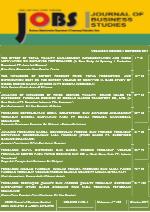STUDY ON THE STRATEGIES OF SEMARANG CONTAINER TERMINAL IN FACING ASEAN ECONOMIC COMMUNITY 2015
DOI:
https://doi.org/10.32497/jobs.v1i2.661Abstract
At the 12th ASEAN Summit, the leader of ASEAN members agree to accelerate the establishment
of ASEAN Community in 2015 and transform ASEAN region with free flow of goods; free flow of
services; free flow of investment; free flow of skilled labor; and free flow of capital. The role of
port of port is crucial in economy development, the presence of capability port plays major role
in supporting people and goods mobility especially the presence of AEC whose element is free
flow of goods in ASEAN countries. To face AEC, people of Indonesia generally and Central Java
especially need some strategies that they might not be a spectator in their own country.
This undergraduate thesis uses qualitative method to describe the strategies of Semarang
Container Terminal in facing AEC and analyzed it by SWOT Analysis, SWOT diagram, and
SWOT matrix. The result of IFAS is 3.6 and EFAS is 3.48, so that the position of Semarang
Container Terminal is in quadrant 1, supporting aggressive strategy. The aggressive strategies
are maximizing the use of the existing facilities to increase company”™s performance, reprogram
Road Show, and do socialization to stakeholder in cooperation with Central Java and
Yogyakarta government (SO Strategy in SWOT matrix).
Key words: strategy, Semarang Container Terminal, ASEAN Economic Community, strength,
opportunity.
Downloads
Published
Issue
Section
License
Authors who publish with this journal agree to the following terms:
Authors retain copyright and grant the journal right of first publication with the work simultaneously licensed under a Creative Commons Attribution License that allows others to share the work with an acknowledgement of the work's authorship and initial publication in this journal.
Authors are able to enter into separate, additional contractual arrangements for the non-exclusive distribution of the journal's published version of the work (e.g., post it to an institutional repository or publish it in a book), with an acknowledgement of its initial publication in this journal.
Authors are permitted and encouraged to post their work online (e.g., in institutional repositories or on their website) prior to and during the submission process, as it can lead to productive exchanges, as well as earlier and greater citation of published work (See The Effect of Open Access).






